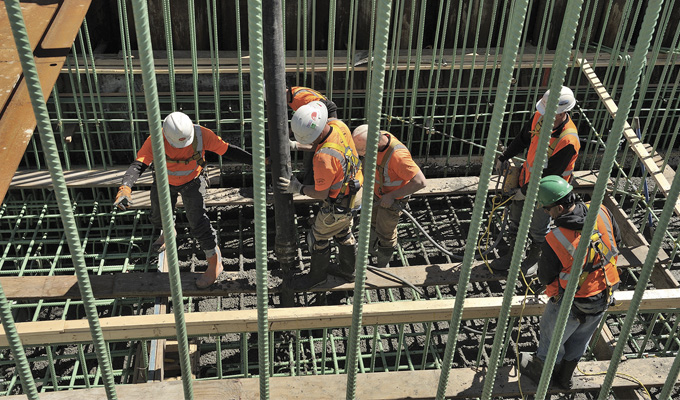When placing concrete in cold weather, extra precautions must be taken to ensure that the concrete sets properly and gains adequate strength. The first few days after placement are the most important because that is when the cement hydration reaction proceeds the fastest and the concrete gains most of its overall strength. However, cold temperatures slow the hydration process, meaning that concrete placed in low temperatures gains less strength than the same mix in warmer temperatures during the same length of time. If the water in the concrete mix freezes, the hydration process stops completely. Even if it thaws, strength gain may not recover.
Therefore, regulating the temperature of concrete in cold weather is essential to its proper strength development. The American Concrete Institute (ACI) specifies in ACI 306R-16 Guide to Cold Weather Concreting recommended concrete temperatures based on the air temperature. It recommends a minimum temperature during placement, minimum temperature at mixing, and maximum allowable gradual temperature drop within 24 hours after the end of protection from the cold weather. These recommendations are often mirrored as requirements in job specifications.
How can you monitor the internal temperature of concrete?
To ensure the internal temperature of concrete does not drop below freezing and is within specified requirements per ACI and/or project specifications, sensors can be embedded in the concrete to continuously monitor and record concrete temperature at regular intervals. This data informs the user of the concrete’s temperature history, so the user can verify compliance with project specifications.
Why is temperature monitoring used in cold weather concreting?
There are three primary reasons that temperature monitoring is used by contractors in cold weather concrete placements:
- Continuous monitoring for potential early-age freezing and thermal shock
- Optimizing curing procedure
- Improving safety of structure
Continuous monitoring for potential early-age freezing and thermal shock
Temperature monitoring can aid the user in keeping fresh and early-age concrete within the project-specified range of temperatures during the curing process to ensure that freezing and thermal shock do not occur.
As previously mentioned, the freezing of the water within the concrete would halt the concrete’s strength gain and prevent it from reaching the necessary level of strength for the construction project. Therefore, the concrete must remain above freezing temperature to properly gain strength while curing.
In addition to ensuring concrete does not freeze, when the curing protection is removed, the concrete is at risk of thermal shock. Thermal shock occurs when the curing is removed too suddenly and there is a large temperature differential between the concrete and the ambient, leading to the surface cooling significantly quicker than the center. The cold surface contracts more than the warmer center, causing tensile stress and cracking in the concrete. By using a temperature monitoring system to ensure that the temperature differential between the concrete and the ambient remains within specifications, thermal shock can be prevented.
OPTIMIZING CURING PROCEDURE
Temperature monitoring systems can often also act as maturity monitoring systems, using temperature history to calculate maturity and using maturity to estimate in-place concrete strength. Knowing both the temperature and estimated strength of the concrete placement can allow the user to optimize curing.
Using temperature data, the user can determine when to modify the concrete temperature by increasing or decreasing thermal control (using heaters, tarps, insulated blankets, etc.). Using maturity data, the user can know when the concrete has gained enough early-age strength to remove the curing protection altogether. Monitoring both temperature and maturity allows the user to adequately cure concrete at job-specified temperatures to the necessary strength without wasting time or money on unneeded curing.
ENSURING SAFETY OF STRUCTURE
Tracking the early-age strength development in the concrete through temperature and maturity monitoring is essential to the safety of the final structure. Because cold weather slows the strength development process, using a maturity system to estimate the in-place progress of the concrete’s strength gain can be good practice to verify that the concrete has reached adequate strength for proceeding in the construction process, reducing the risk for premature structural failure.
Using temperature and maturity monitoring systems in cold weather concreting
Continuous temperature monitoring is essential to cold weather concreting. Using a non-destructive temperature and strength monitoring system such as COMMAND Center is the best choice for users to know, throughout the curing process, if their concrete is meeting a project’s thermal specifications.
The COMMAND Center system is the optimal choice for monitoring because it is affordable, easy to use, and has been proven to be reliable in the field. The system includes self-powered sensors and powerful software for viewing, analyzing, and reporting data. Sensors come pre-programmed and do not require initialization in the field, and the same sensors that collect temperature data can also be used to measure maturity. COMMAND Center software is free and allows the user to toggle between Celsius and Fahrenheit as well as view and analyze temperature data for individual sensors or compare data from multiple sensors at once—ideal for monitoring the temperature differential between the concrete and ambient to prevent thermal shock.
CLOSING THOUGHT
Temperature and maturity monitoring of cold weather concrete is required in most cold-weather concreting applications and is essential to identifying the potential for freezing and thermal shock, optimizing curing, and ensuring safety of a structure. Temperature and maturity monitoring systems like COMMAND Center provide a user-friendly, affordable option for this purpose. By continuously collecting temperature data, users can optimize cold-weather curing and thermal control procedures based on project specifications to ensure structural safety and save money on curing methods.
for more information:
For more, visit COMMAND Center at www.commandcenterconcrete.com,
a division of The Transtec Group, Inc. at www.thetranstecgroup.com.
Modern Contractor Solutions, December 2019
Did you enjoy this article?
Subscribe to the FREE Digital Edition of Modern Contractor Solutions magazine.



